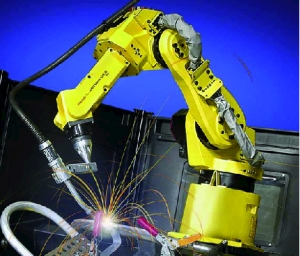AMAZON multi-meters discounts AMAZON oscilloscope discounts

 You
are working in a shop that has several robots used in material handling
applications. It has been determined that robots could be used in several
other applications in your shop such as machine loading, welding, or painting.
You
are working in a shop that has several robots used in material handling
applications. It has been determined that robots could be used in several
other applications in your shop such as machine loading, welding, or painting.
Your assignment is to select the type of robots that you think would best accomplish one of these applications.
AMAZON multi-meters discounts AMAZON oscilloscope discounts
You must also select the type of programming and determine the electronic signals that must be sent to each robot and received by each robot. You must also determine if a PLC is required to handle the signals between the robots and the machines used in the application. When you have collected all of the material, you must present your proposal to your shop quality improvement team. The proposal should include sketches of the types of robots you have selected, the list of signals that must be sent and received by each robot, and the type of programming each robot should have. Use one of the applications provided in these sections (Automotive Welding Line, Loading and Unloading Bonding Machines, Robotic Painting Cells) as your project and review it to provide the details of the robot application.
SOLUTION
Your solution to the job should include a reference to one of the applications in Industrial Robots Used In Typical Work Cells And Manufacturing Cells. You can use information from Types of Robots to select the type of robot that you’ll need to accomplish this job. You should include the advantages the type of robot you selected provides over other types of robots that you didn’t select. From the example in Input Circuits for Industrial Robot Signals you should have an idea of the input and output signals available in the robot. This section also provides an example of the interfacing function the PLC provides between the robot and the work cell, or between multiple robots. If your application includes more than one robot, a PLC should be included to help sequence the interface between the robots. The reason you may choose to use the PLC to interface two or more robots in a work cell is that the PLC program is a continuous-scan program, and it can receive or send a signal at any time. In comparison, the robot program is a step program, and the robot is only ready to receive or send a signal when it's on the correct step. That is, if two robots try to interface, it's possible that one will have to wait on the other to send or receive a signal. If the PLC is used, it can receive or send a signal at anytime to get around synchronizing problems between robots. The PLC is also used as an interface because it can be connected to a wide variety of color screens to provide operator information.
Your solution should include signals for your applications between the various parts of the work cell and to other robots if they are used. For instance, typical signals between the cell and the robot and between the robot control cabinet and parts on the robot would include: part in place, open fixture, close fixture, turn on gripper, start weld, stop weld, and so on. Signals between two robots may include: robot in exclusive work space, robot out of exclusive work space, request to start job cycle, and job cycle complete.
| Top of Page | PREV: Review of Industrial Robotics | NEXT: Industrial Robotics Quiz |